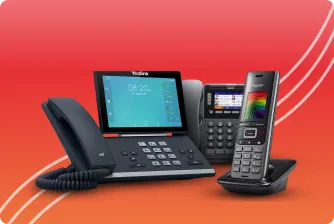In today’s fast-paced business world, having a reliable and effective telecoms system is essential for businesses of all sizes. Business telecoms refer to the range of communication technologies and services that enable businesses to communicate with their customers, suppliers, and employees.
Customer service and customer retention are vital for any business, and a great telecoms system can help improve both. As industry expert Michael Wood puts it, “Having a strong telecoms infrastructure is crucial for businesses to effectively engage with customers and build long-lasting relationships.” According to research by American Express, “89% of customers are more likely to do business with a company that offers great customer service.”
In this blog, we will explore how business telecoms can help businesses improve their customer service and retention, and provide a complete guide on how to choose and implement the right system for your business.
Understanding Business Telecoms
Business telecoms is a term that encompasses a wide range of communication technologies and services that businesses use to communicate with their stakeholders, including customers, suppliers, and employees. According to industry expert, Michael Wood, “Effective communication is the backbone of any successful business, and a strong telecoms system is essential to achieving this.” Business telecoms can include voice, data, video, and other communication channels that allow businesses to interact with their customers through various mediums.
There are several types of business telecoms available, including traditional landlines, Voice over Internet Protocol (VoIP), and mobile devices. Each type of telecoms system has its benefits and limitations, and the right choice will depend on a business’s specific needs and budget. Regardless of the type of system chosen, business telecoms can provide numerous benefits for customer service and retention, including faster response times, better call quality, and improved customer engagement.
Additionally, business telecoms systems can help businesses streamline their communication processes, allowing them to better manage and track customer interactions. As technology continues to evolve, so do the capabilities of business telecoms. For instance, AI-powered virtual assistants and chatbots are becoming increasingly popular tools for businesses to enhance their customer service offerings.
Overall, understanding the different types of business telecoms available and how they can benefit a business is crucial in today’s market. By providing a reliable and efficient communication system, businesses can improve customer service and retention, leading to increased satisfaction and revenue.
Improving Customer Service
Business telecoms can be a valuable tool in improving customer service for businesses. By using various communication channels and technologies, businesses can better understand and meet their customer’s needs and preferences. According to customer service expert Shep Hyken, “Customers don’t expect you to be perfect. They do expect you to fix things when they go wrong.” Business telecoms can help businesses do just that by providing timely and effective customer service.
One way that business telecoms can improve customer service is by identifying customer needs and preferences. By using data analytics tools, businesses can gather information about their customers’ behaviour, communication channels, and preferred methods of contact. This information can then be used to tailor customer service experiences to each individual customer, leading to increased satisfaction and retention.
Another way that business telecoms can enhance customer service is by providing personalized experiences. This can include using customer data to address them by name or offering customized recommendations based on their purchase history. Personalized experiences can create a strong emotional connection between the customer and the business, leading to increased loyalty and advocacy.
Business telecoms can also help businesses respond to customer inquiries and complaints more efficiently. By using call routing and IVR (Interactive Voice Response) systems, businesses can direct customer inquiries to the appropriate department or agent, leading to faster resolution times. Additionally, businesses can use chatbots or virtual assistants to provide 24/7 customer support, improving accessibility and convenience for customers.
In conclusion, business telecoms can help businesses improve their customer service by understanding and meeting customer needs and preferences, providing personalized experiences, and responding to inquiries and complaints more efficiently. By utilizing the various communication channels and technologies available through business telecoms, businesses can enhance customer satisfaction and retention, leading to increased revenue and growth. As customer experience expert Jeanne Bliss notes, “Customer experience isn’t an expense, it’s an investment in loyalty.”
Enhancing Customer Retention
Customer retention is critical for any business looking to sustain long-term success. Business telecoms can help enhance customer retention by providing tools that enable businesses to stay connected with their customers and provide better experiences. According to business expert, John Tschohl, “It takes a lot less effort and money to keep an existing customer than to acquire a new one.”
Business telecoms can help businesses stay in touch with their customers through various communication channels, including email, SMS, social media, and phone calls. By staying connected with customers, businesses can build stronger relationships and provide ongoing support, leading to increased loyalty and retention.
Another way that business telecoms can enhance customer retention is by providing targeted marketing and sales campaigns. By using data analytics tools, businesses can gather information about their customer’s behaviour and preferences, allowing them to create personalized marketing and sales campaigns. This can include targeted promotions, upsell and cross-sell offers, and loyalty programs. According to marketing expert, Neil Patel, “Personalization is no longer an option, it’s a requirement.”
Business telecoms can also help businesses monitor and track customer satisfaction and feedback. By using survey tools and feedback loops, businesses can gather feedback from customers and use this information to improve their products, services, and customer experiences. This can lead to increased customer satisfaction and retention.
Overall, business telecoms can be a powerful tool in enhancing customer retention for businesses. By staying connected with customers, providing targeted marketing and sales campaigns, and monitoring customer feedback, businesses can build strong relationships with their customers and keep them coming back. As customer service expert, Kate Zabriskie, notes, “The customer’s perception is your reality.” By utilizing business telecoms to improve customer perception and experience, businesses can improve their bottom line and achieve sustained growth.
Implementing A New System
Implementing business telecoms for improved customer service and retention requires a strategic approach that considers the unique needs and preferences of each business and its customers. The first step is to assess the current customer service and retention processes and identify areas for improvement. As customer experience expert, Bruce Temkin, notes, “You can’t improve what you don’t measure.”
Once the areas for improvement have been identified, businesses can then select the appropriate telecoms tools and technologies to support their goals. This can include call routing and IVR systems, chatbots and virtual assistants, email and SMS marketing, and data analytics tools. It’s essential to select tools that integrate seamlessly with existing systems and processes to avoid disruption and ensure a smooth implementation.
Training and support are also critical for successful implementation. Employees must be trained on how to use the new tools and technologies effectively, and support must be provided to address any issues that arise. Ongoing training and support can also help employees stay up to date with new features and capabilities and ensure the continued success of the implementation.
Finally, businesses must continually monitor and evaluate the effectiveness of the telecoms tools and technologies to ensure they are meeting their goals. This can include gathering customer feedback, analyzing data analytics, and measuring retention rates. As customer service expert, Bill Quiseng, notes, “What gets measured gets improved.”
In conclusion, implementing business telecoms for improved customer service and retention requires a strategic approach that considers the unique needs and preferences of each business and its customers. By assessing current processes, selecting the appropriate tools and technologies, providing training and support, and monitoring and evaluating effectiveness, businesses can achieve sustained growth and success. As customer experience expert, Shep Hyken, notes, “Customer service is not a department, it’s a philosophy.” By implementing business telecoms, businesses can adopt a customer-centric philosophy that leads to increased satisfaction, retention, and revenue.
Conclusion
In conclusion, implementing business telecoms can significantly improve customer service and retention for businesses. By using tools and technologies such as call routing, chatbots, and data analytics, businesses can stay connected with their customers and provide personalised experiences that lead to increased loyalty and retention. As customer service expert, Tony Hsieh, notes, “Customer service shouldn’t just be a department, it should be the entire company.”
However, successful implementation requires a strategic approach that considers the unique needs and preferences of each business and its customers. By assessing current processes, selecting appropriate tools, providing training and support, and monitoring and evaluating effectiveness, businesses can achieve sustained growth and success.
Ultimately, the success of any business depends on its ability to satisfy and retain its customers. By utilising business telecoms to enhance customer service and retention, businesses can create a competitive advantage and achieve long-term success. As business expert, Peter Drucker, notes, “The purpose of a business is to create a customer who creates customers.” By implementing business telecoms, businesses can create satisfied customers who, in turn, become loyal advocates for their brand.











